Report on Leadership, Management Operations: TESCO PLC Case Study
VerifiedAdded on 2020/06/05
|13
|4539
|27
Report
AI Summary
This report analyzes leadership and management operations, using TESCO PLC as a case study. It explores the different roles and characteristics of leaders and managers, comparing and contrasting them, and examining how they apply in various situations. The report delves into situational, system, and contingency leadership theories, and also examines key approaches to operations management. It discusses the importance and value of operations management in achieving business objectives, and the factors in the business environment that impact operations management and decision-making. The report covers management functions such as planning, organizing, leading, and controlling, as well as the ten roles of a leader as categorized by Mintzberg. It highlights the importance of adapting to changing situations and the application of different leadership styles to handle specific tasks within an organization like TESCO.
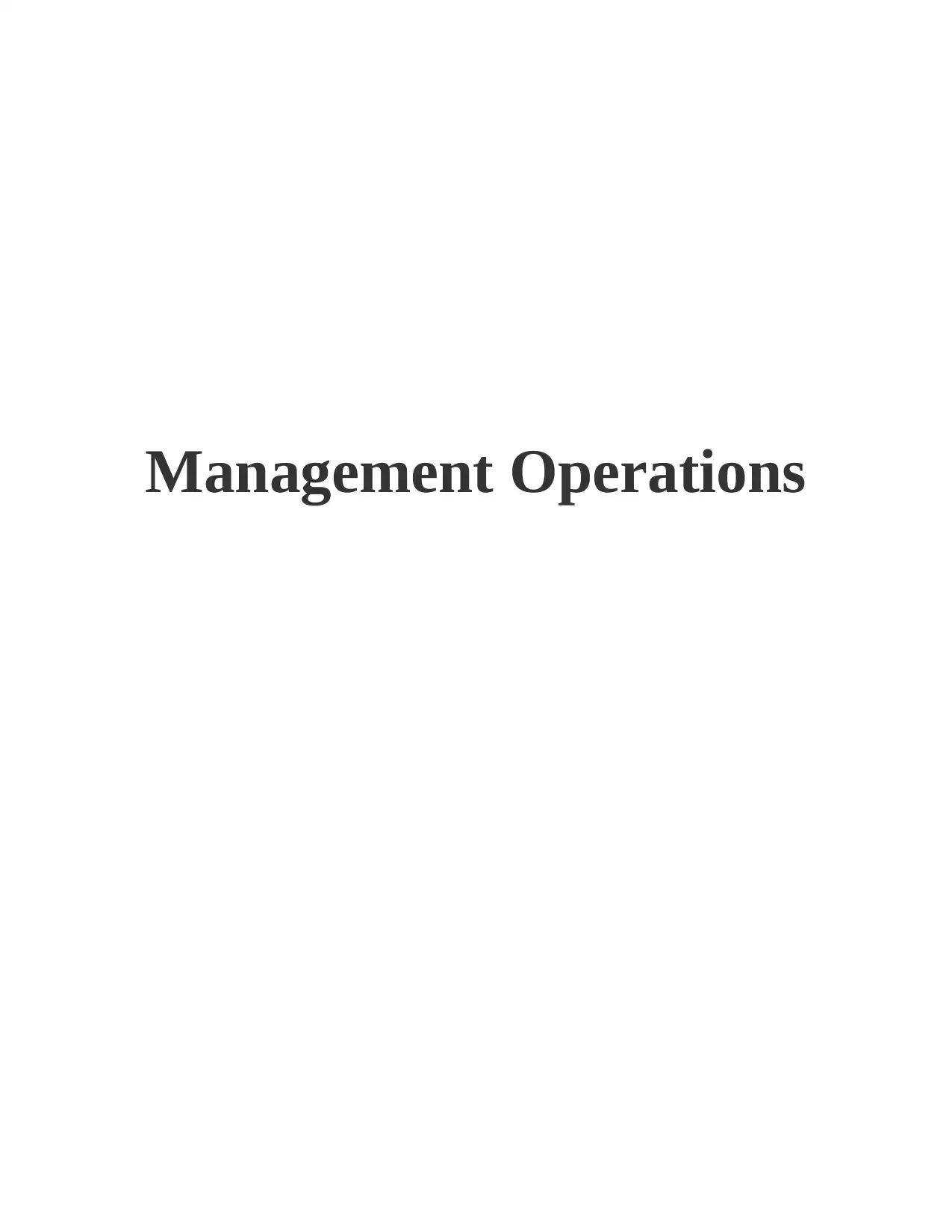
Management Operations
Paraphrase This Document
Need a fresh take? Get an instant paraphrase of this document with our AI Paraphraser
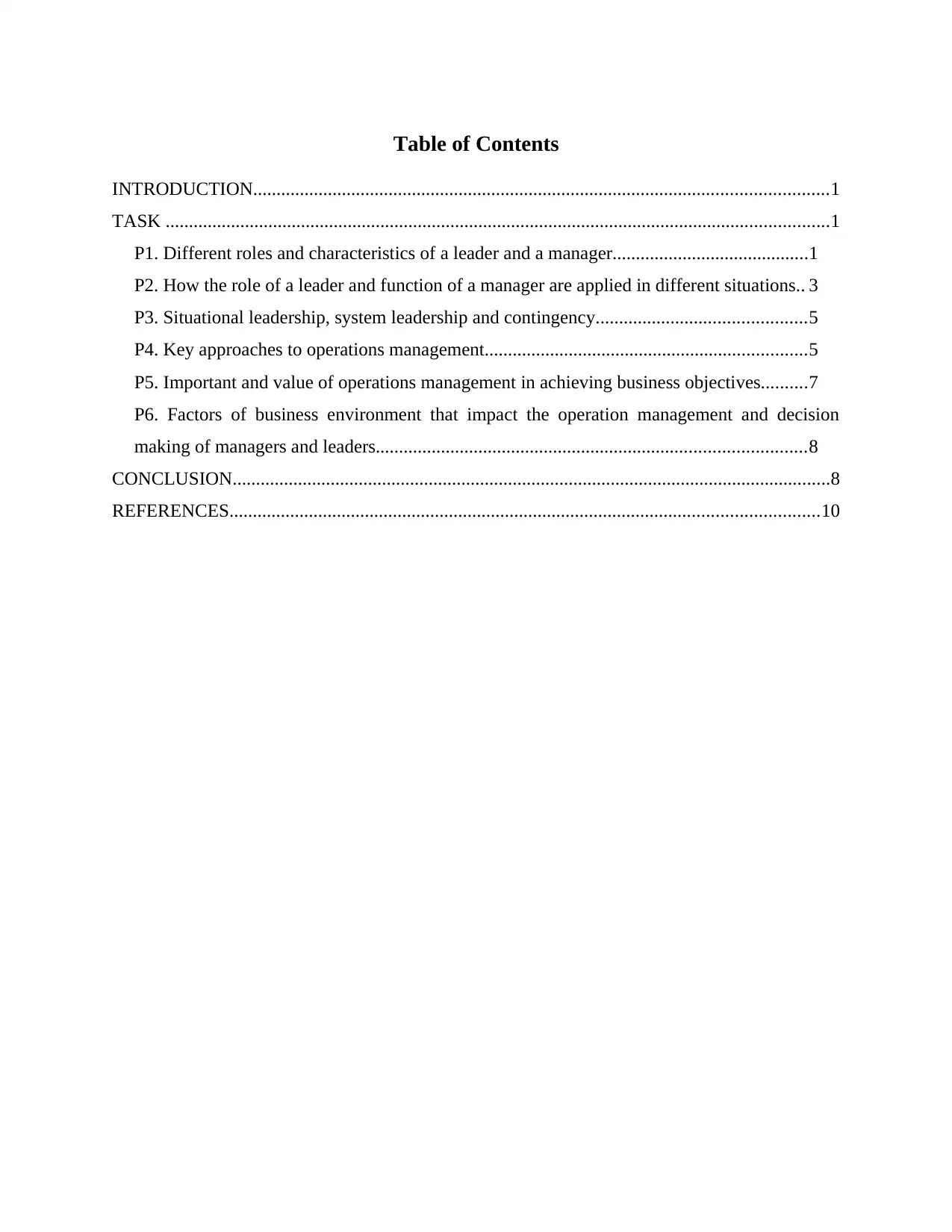
Table of Contents
INTRODUCTION...........................................................................................................................1
TASK ..............................................................................................................................................1
P1. Different roles and characteristics of a leader and a manager..........................................1
P2. How the role of a leader and function of a manager are applied in different situations.. 3
P3. Situational leadership, system leadership and contingency.............................................5
P4. Key approaches to operations management.....................................................................5
P5. Important and value of operations management in achieving business objectives..........7
P6. Factors of business environment that impact the operation management and decision
making of managers and leaders............................................................................................8
CONCLUSION................................................................................................................................8
REFERENCES..............................................................................................................................10
INTRODUCTION...........................................................................................................................1
TASK ..............................................................................................................................................1
P1. Different roles and characteristics of a leader and a manager..........................................1
P2. How the role of a leader and function of a manager are applied in different situations.. 3
P3. Situational leadership, system leadership and contingency.............................................5
P4. Key approaches to operations management.....................................................................5
P5. Important and value of operations management in achieving business objectives..........7
P6. Factors of business environment that impact the operation management and decision
making of managers and leaders............................................................................................8
CONCLUSION................................................................................................................................8
REFERENCES..............................................................................................................................10
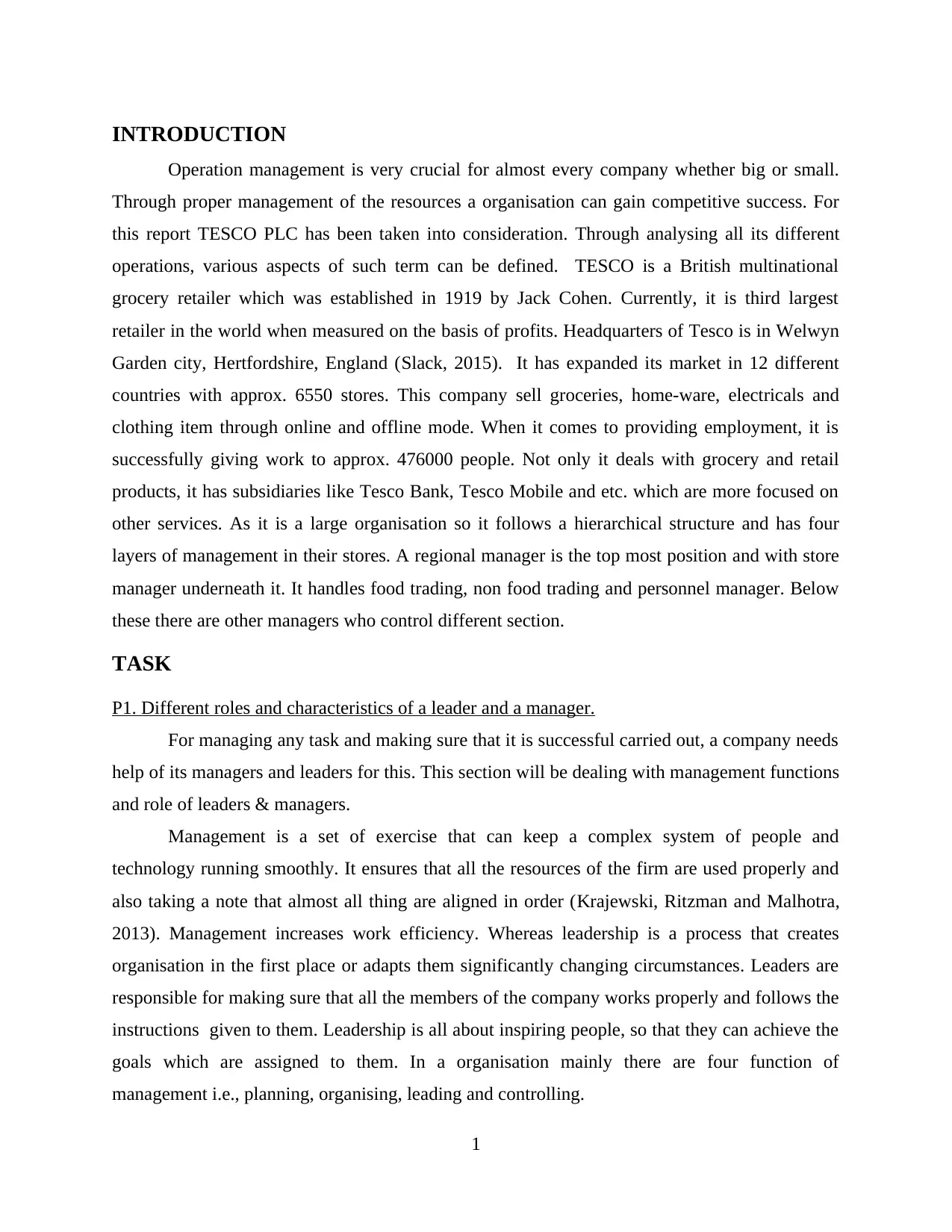
INTRODUCTION
Operation management is very crucial for almost every company whether big or small.
Through proper management of the resources a organisation can gain competitive success. For
this report TESCO PLC has been taken into consideration. Through analysing all its different
operations, various aspects of such term can be defined. TESCO is a British multinational
grocery retailer which was established in 1919 by Jack Cohen. Currently, it is third largest
retailer in the world when measured on the basis of profits. Headquarters of Tesco is in Welwyn
Garden city, Hertfordshire, England (Slack, 2015). It has expanded its market in 12 different
countries with approx. 6550 stores. This company sell groceries, home-ware, electricals and
clothing item through online and offline mode. When it comes to providing employment, it is
successfully giving work to approx. 476000 people. Not only it deals with grocery and retail
products, it has subsidiaries like Tesco Bank, Tesco Mobile and etc. which are more focused on
other services. As it is a large organisation so it follows a hierarchical structure and has four
layers of management in their stores. A regional manager is the top most position and with store
manager underneath it. It handles food trading, non food trading and personnel manager. Below
these there are other managers who control different section.
TASK
P1. Different roles and characteristics of a leader and a manager.
For managing any task and making sure that it is successful carried out, a company needs
help of its managers and leaders for this. This section will be dealing with management functions
and role of leaders & managers.
Management is a set of exercise that can keep a complex system of people and
technology running smoothly. It ensures that all the resources of the firm are used properly and
also taking a note that almost all thing are aligned in order (Krajewski, Ritzman and Malhotra,
2013). Management increases work efficiency. Whereas leadership is a process that creates
organisation in the first place or adapts them significantly changing circumstances. Leaders are
responsible for making sure that all the members of the company works properly and follows the
instructions given to them. Leadership is all about inspiring people, so that they can achieve the
goals which are assigned to them. In a organisation mainly there are four function of
management i.e., planning, organising, leading and controlling.
1
Operation management is very crucial for almost every company whether big or small.
Through proper management of the resources a organisation can gain competitive success. For
this report TESCO PLC has been taken into consideration. Through analysing all its different
operations, various aspects of such term can be defined. TESCO is a British multinational
grocery retailer which was established in 1919 by Jack Cohen. Currently, it is third largest
retailer in the world when measured on the basis of profits. Headquarters of Tesco is in Welwyn
Garden city, Hertfordshire, England (Slack, 2015). It has expanded its market in 12 different
countries with approx. 6550 stores. This company sell groceries, home-ware, electricals and
clothing item through online and offline mode. When it comes to providing employment, it is
successfully giving work to approx. 476000 people. Not only it deals with grocery and retail
products, it has subsidiaries like Tesco Bank, Tesco Mobile and etc. which are more focused on
other services. As it is a large organisation so it follows a hierarchical structure and has four
layers of management in their stores. A regional manager is the top most position and with store
manager underneath it. It handles food trading, non food trading and personnel manager. Below
these there are other managers who control different section.
TASK
P1. Different roles and characteristics of a leader and a manager.
For managing any task and making sure that it is successful carried out, a company needs
help of its managers and leaders for this. This section will be dealing with management functions
and role of leaders & managers.
Management is a set of exercise that can keep a complex system of people and
technology running smoothly. It ensures that all the resources of the firm are used properly and
also taking a note that almost all thing are aligned in order (Krajewski, Ritzman and Malhotra,
2013). Management increases work efficiency. Whereas leadership is a process that creates
organisation in the first place or adapts them significantly changing circumstances. Leaders are
responsible for making sure that all the members of the company works properly and follows the
instructions given to them. Leadership is all about inspiring people, so that they can achieve the
goals which are assigned to them. In a organisation mainly there are four function of
management i.e., planning, organising, leading and controlling.
1
⊘ This is a preview!⊘
Do you want full access?
Subscribe today to unlock all pages.

Trusted by 1+ million students worldwide
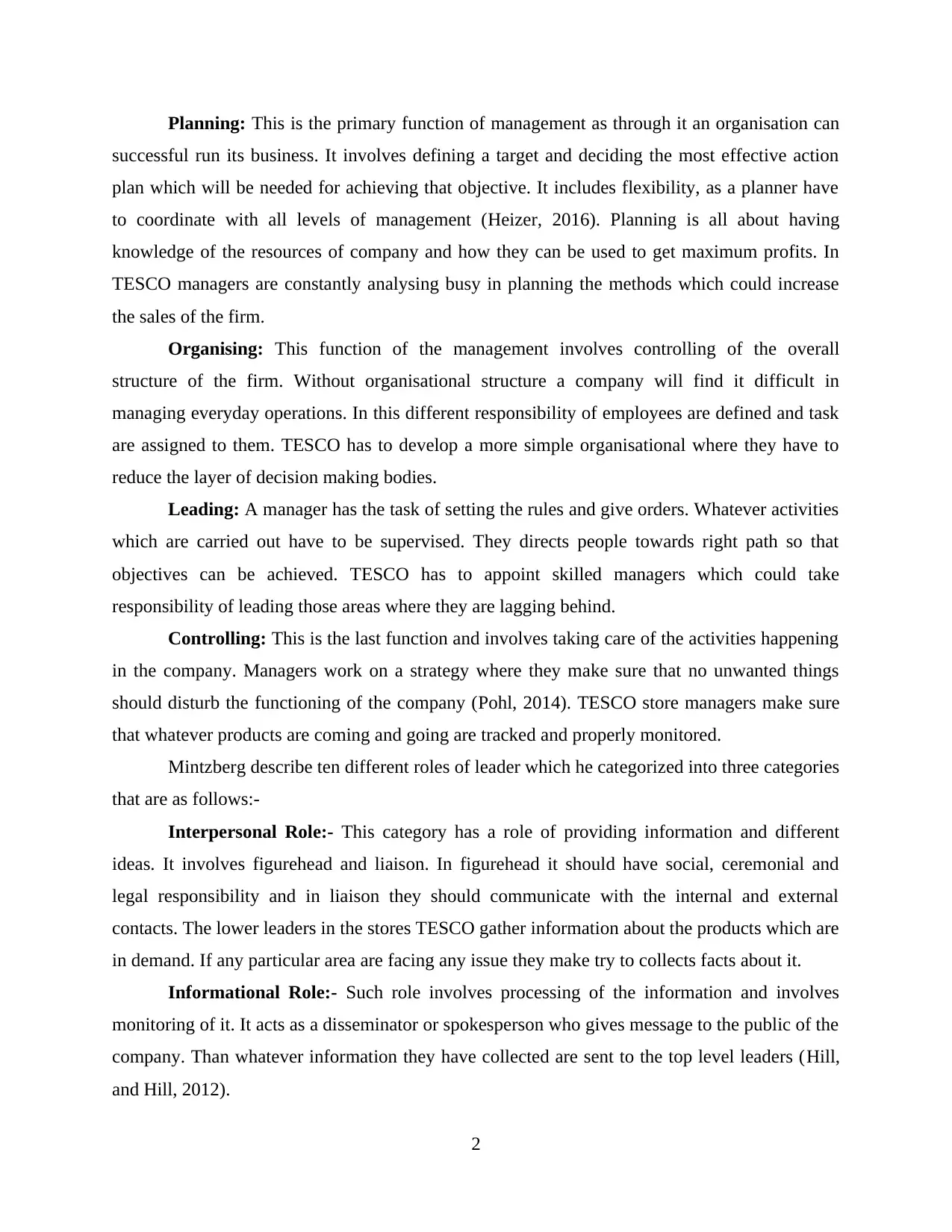
Planning: This is the primary function of management as through it an organisation can
successful run its business. It involves defining a target and deciding the most effective action
plan which will be needed for achieving that objective. It includes flexibility, as a planner have
to coordinate with all levels of management (Heizer, 2016). Planning is all about having
knowledge of the resources of company and how they can be used to get maximum profits. In
TESCO managers are constantly analysing busy in planning the methods which could increase
the sales of the firm.
Organising: This function of the management involves controlling of the overall
structure of the firm. Without organisational structure a company will find it difficult in
managing everyday operations. In this different responsibility of employees are defined and task
are assigned to them. TESCO has to develop a more simple organisational where they have to
reduce the layer of decision making bodies.
Leading: A manager has the task of setting the rules and give orders. Whatever activities
which are carried out have to be supervised. They directs people towards right path so that
objectives can be achieved. TESCO has to appoint skilled managers which could take
responsibility of leading those areas where they are lagging behind.
Controlling: This is the last function and involves taking care of the activities happening
in the company. Managers work on a strategy where they make sure that no unwanted things
should disturb the functioning of the company (Pohl, 2014). TESCO store managers make sure
that whatever products are coming and going are tracked and properly monitored.
Mintzberg describe ten different roles of leader which he categorized into three categories
that are as follows:-
Interpersonal Role:- This category has a role of providing information and different
ideas. It involves figurehead and liaison. In figurehead it should have social, ceremonial and
legal responsibility and in liaison they should communicate with the internal and external
contacts. The lower leaders in the stores TESCO gather information about the products which are
in demand. If any particular area are facing any issue they make try to collects facts about it.
Informational Role:- Such role involves processing of the information and involves
monitoring of it. It acts as a disseminator or spokesperson who gives message to the public of the
company. Than whatever information they have collected are sent to the top level leaders (Hill,
and Hill, 2012).
2
successful run its business. It involves defining a target and deciding the most effective action
plan which will be needed for achieving that objective. It includes flexibility, as a planner have
to coordinate with all levels of management (Heizer, 2016). Planning is all about having
knowledge of the resources of company and how they can be used to get maximum profits. In
TESCO managers are constantly analysing busy in planning the methods which could increase
the sales of the firm.
Organising: This function of the management involves controlling of the overall
structure of the firm. Without organisational structure a company will find it difficult in
managing everyday operations. In this different responsibility of employees are defined and task
are assigned to them. TESCO has to develop a more simple organisational where they have to
reduce the layer of decision making bodies.
Leading: A manager has the task of setting the rules and give orders. Whatever activities
which are carried out have to be supervised. They directs people towards right path so that
objectives can be achieved. TESCO has to appoint skilled managers which could take
responsibility of leading those areas where they are lagging behind.
Controlling: This is the last function and involves taking care of the activities happening
in the company. Managers work on a strategy where they make sure that no unwanted things
should disturb the functioning of the company (Pohl, 2014). TESCO store managers make sure
that whatever products are coming and going are tracked and properly monitored.
Mintzberg describe ten different roles of leader which he categorized into three categories
that are as follows:-
Interpersonal Role:- This category has a role of providing information and different
ideas. It involves figurehead and liaison. In figurehead it should have social, ceremonial and
legal responsibility and in liaison they should communicate with the internal and external
contacts. The lower leaders in the stores TESCO gather information about the products which are
in demand. If any particular area are facing any issue they make try to collects facts about it.
Informational Role:- Such role involves processing of the information and involves
monitoring of it. It acts as a disseminator or spokesperson who gives message to the public of the
company. Than whatever information they have collected are sent to the top level leaders (Hill,
and Hill, 2012).
2
Paraphrase This Document
Need a fresh take? Get an instant paraphrase of this document with our AI Paraphraser
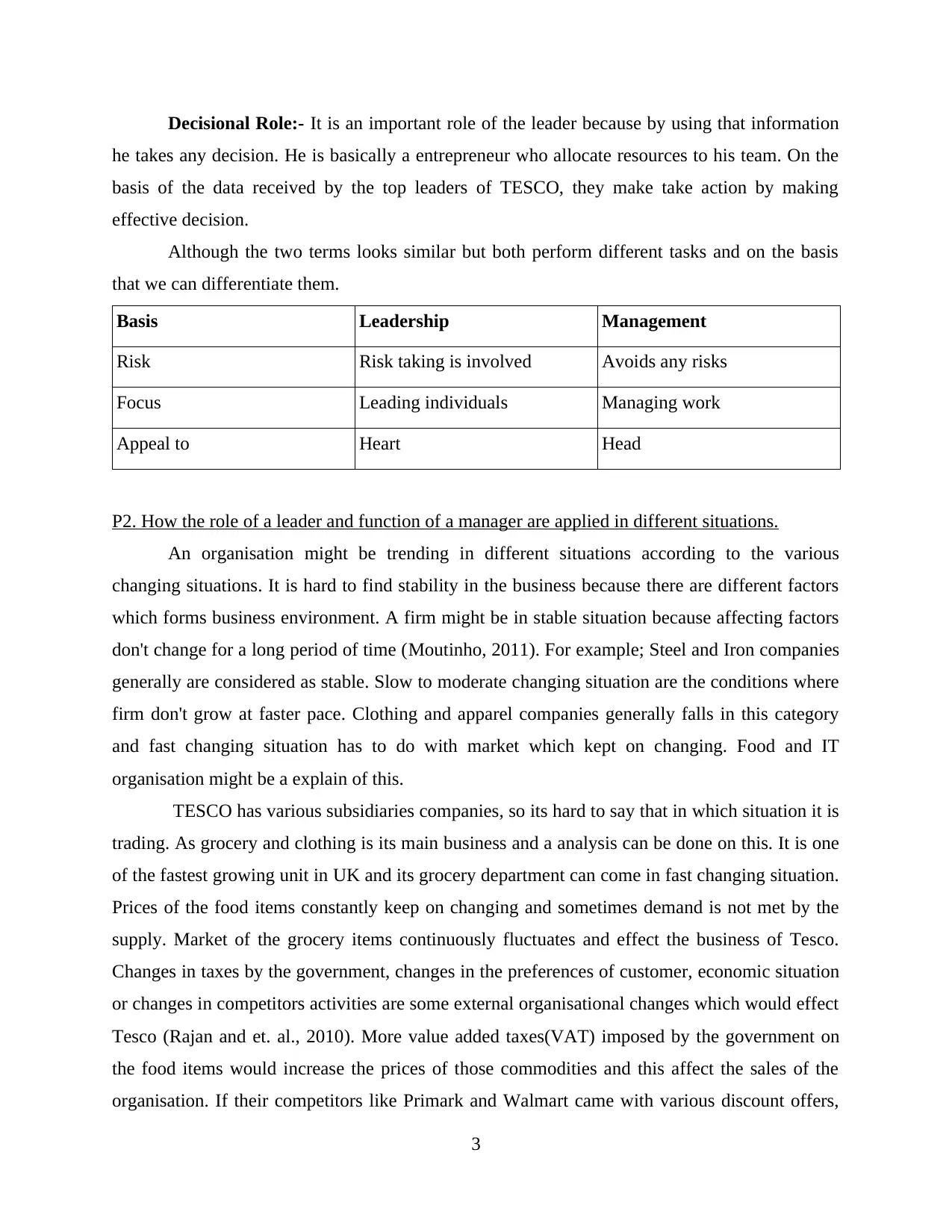
Decisional Role:- It is an important role of the leader because by using that information
he takes any decision. He is basically a entrepreneur who allocate resources to his team. On the
basis of the data received by the top leaders of TESCO, they make take action by making
effective decision.
Although the two terms looks similar but both perform different tasks and on the basis
that we can differentiate them.
Basis Leadership Management
Risk Risk taking is involved Avoids any risks
Focus Leading individuals Managing work
Appeal to Heart Head
P2. How the role of a leader and function of a manager are applied in different situations.
An organisation might be trending in different situations according to the various
changing situations. It is hard to find stability in the business because there are different factors
which forms business environment. A firm might be in stable situation because affecting factors
don't change for a long period of time (Moutinho, 2011). For example; Steel and Iron companies
generally are considered as stable. Slow to moderate changing situation are the conditions where
firm don't grow at faster pace. Clothing and apparel companies generally falls in this category
and fast changing situation has to do with market which kept on changing. Food and IT
organisation might be a explain of this.
TESCO has various subsidiaries companies, so its hard to say that in which situation it is
trading. As grocery and clothing is its main business and a analysis can be done on this. It is one
of the fastest growing unit in UK and its grocery department can come in fast changing situation.
Prices of the food items constantly keep on changing and sometimes demand is not met by the
supply. Market of the grocery items continuously fluctuates and effect the business of Tesco.
Changes in taxes by the government, changes in the preferences of customer, economic situation
or changes in competitors activities are some external organisational changes which would effect
Tesco (Rajan and et. al., 2010). More value added taxes(VAT) imposed by the government on
the food items would increase the prices of those commodities and this affect the sales of the
organisation. If their competitors like Primark and Walmart came with various discount offers,
3
he takes any decision. He is basically a entrepreneur who allocate resources to his team. On the
basis of the data received by the top leaders of TESCO, they make take action by making
effective decision.
Although the two terms looks similar but both perform different tasks and on the basis
that we can differentiate them.
Basis Leadership Management
Risk Risk taking is involved Avoids any risks
Focus Leading individuals Managing work
Appeal to Heart Head
P2. How the role of a leader and function of a manager are applied in different situations.
An organisation might be trending in different situations according to the various
changing situations. It is hard to find stability in the business because there are different factors
which forms business environment. A firm might be in stable situation because affecting factors
don't change for a long period of time (Moutinho, 2011). For example; Steel and Iron companies
generally are considered as stable. Slow to moderate changing situation are the conditions where
firm don't grow at faster pace. Clothing and apparel companies generally falls in this category
and fast changing situation has to do with market which kept on changing. Food and IT
organisation might be a explain of this.
TESCO has various subsidiaries companies, so its hard to say that in which situation it is
trading. As grocery and clothing is its main business and a analysis can be done on this. It is one
of the fastest growing unit in UK and its grocery department can come in fast changing situation.
Prices of the food items constantly keep on changing and sometimes demand is not met by the
supply. Market of the grocery items continuously fluctuates and effect the business of Tesco.
Changes in taxes by the government, changes in the preferences of customer, economic situation
or changes in competitors activities are some external organisational changes which would effect
Tesco (Rajan and et. al., 2010). More value added taxes(VAT) imposed by the government on
the food items would increase the prices of those commodities and this affect the sales of the
organisation. If their competitors like Primark and Walmart came with various discount offers,
3
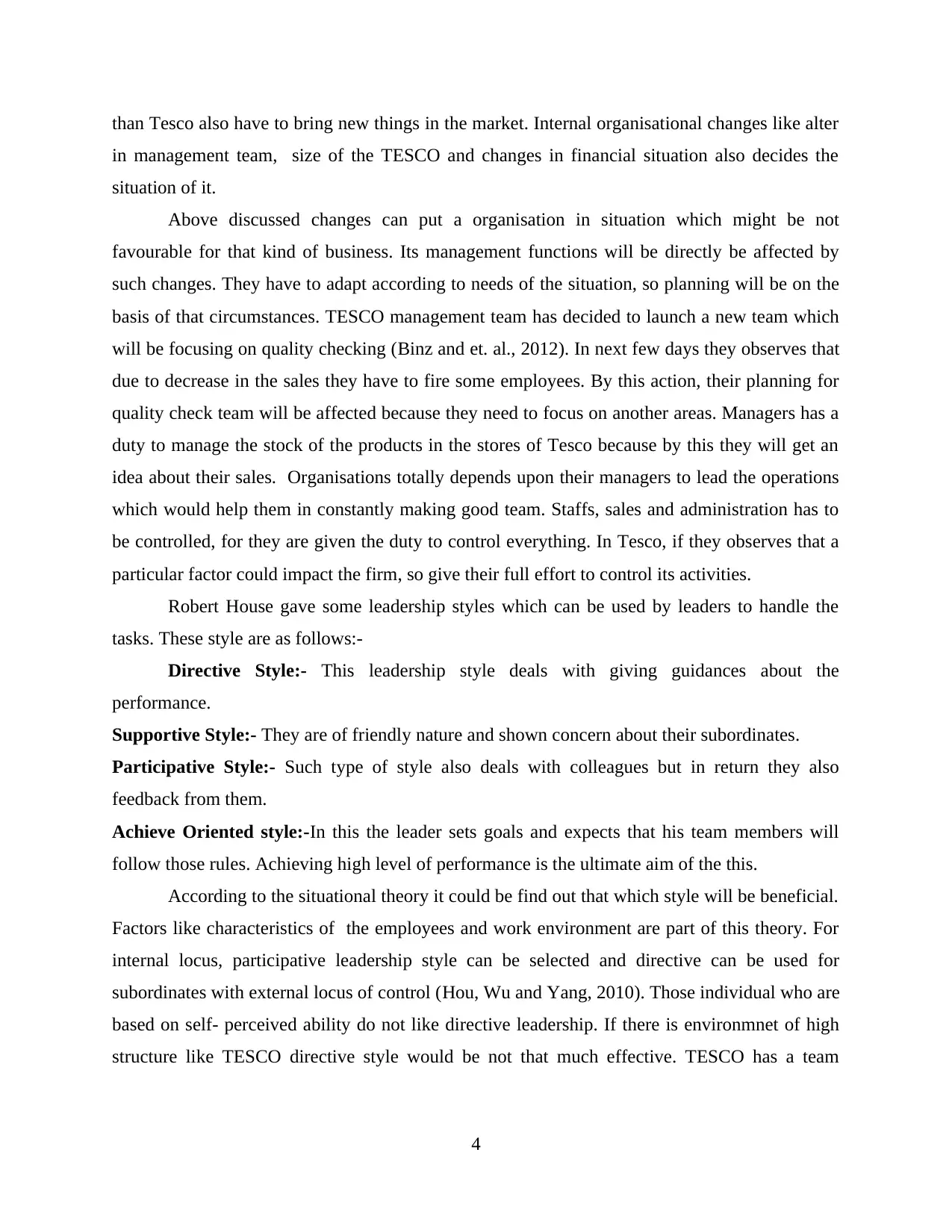
than Tesco also have to bring new things in the market. Internal organisational changes like alter
in management team, size of the TESCO and changes in financial situation also decides the
situation of it.
Above discussed changes can put a organisation in situation which might be not
favourable for that kind of business. Its management functions will be directly be affected by
such changes. They have to adapt according to needs of the situation, so planning will be on the
basis of that circumstances. TESCO management team has decided to launch a new team which
will be focusing on quality checking (Binz and et. al., 2012). In next few days they observes that
due to decrease in the sales they have to fire some employees. By this action, their planning for
quality check team will be affected because they need to focus on another areas. Managers has a
duty to manage the stock of the products in the stores of Tesco because by this they will get an
idea about their sales. Organisations totally depends upon their managers to lead the operations
which would help them in constantly making good team. Staffs, sales and administration has to
be controlled, for they are given the duty to control everything. In Tesco, if they observes that a
particular factor could impact the firm, so give their full effort to control its activities.
Robert House gave some leadership styles which can be used by leaders to handle the
tasks. These style are as follows:-
Directive Style:- This leadership style deals with giving guidances about the
performance.
Supportive Style:- They are of friendly nature and shown concern about their subordinates.
Participative Style:- Such type of style also deals with colleagues but in return they also
feedback from them.
Achieve Oriented style:-In this the leader sets goals and expects that his team members will
follow those rules. Achieving high level of performance is the ultimate aim of the this.
According to the situational theory it could be find out that which style will be beneficial.
Factors like characteristics of the employees and work environment are part of this theory. For
internal locus, participative leadership style can be selected and directive can be used for
subordinates with external locus of control (Hou, Wu and Yang, 2010). Those individual who are
based on self- perceived ability do not like directive leadership. If there is environmnet of high
structure like TESCO directive style would be not that much effective. TESCO has a team
4
in management team, size of the TESCO and changes in financial situation also decides the
situation of it.
Above discussed changes can put a organisation in situation which might be not
favourable for that kind of business. Its management functions will be directly be affected by
such changes. They have to adapt according to needs of the situation, so planning will be on the
basis of that circumstances. TESCO management team has decided to launch a new team which
will be focusing on quality checking (Binz and et. al., 2012). In next few days they observes that
due to decrease in the sales they have to fire some employees. By this action, their planning for
quality check team will be affected because they need to focus on another areas. Managers has a
duty to manage the stock of the products in the stores of Tesco because by this they will get an
idea about their sales. Organisations totally depends upon their managers to lead the operations
which would help them in constantly making good team. Staffs, sales and administration has to
be controlled, for they are given the duty to control everything. In Tesco, if they observes that a
particular factor could impact the firm, so give their full effort to control its activities.
Robert House gave some leadership styles which can be used by leaders to handle the
tasks. These style are as follows:-
Directive Style:- This leadership style deals with giving guidances about the
performance.
Supportive Style:- They are of friendly nature and shown concern about their subordinates.
Participative Style:- Such type of style also deals with colleagues but in return they also
feedback from them.
Achieve Oriented style:-In this the leader sets goals and expects that his team members will
follow those rules. Achieving high level of performance is the ultimate aim of the this.
According to the situational theory it could be find out that which style will be beneficial.
Factors like characteristics of the employees and work environment are part of this theory. For
internal locus, participative leadership style can be selected and directive can be used for
subordinates with external locus of control (Hou, Wu and Yang, 2010). Those individual who are
based on self- perceived ability do not like directive leadership. If there is environmnet of high
structure like TESCO directive style would be not that much effective. TESCO has a team
4
⊘ This is a preview!⊘
Do you want full access?
Subscribe today to unlock all pages.

Trusted by 1+ million students worldwide
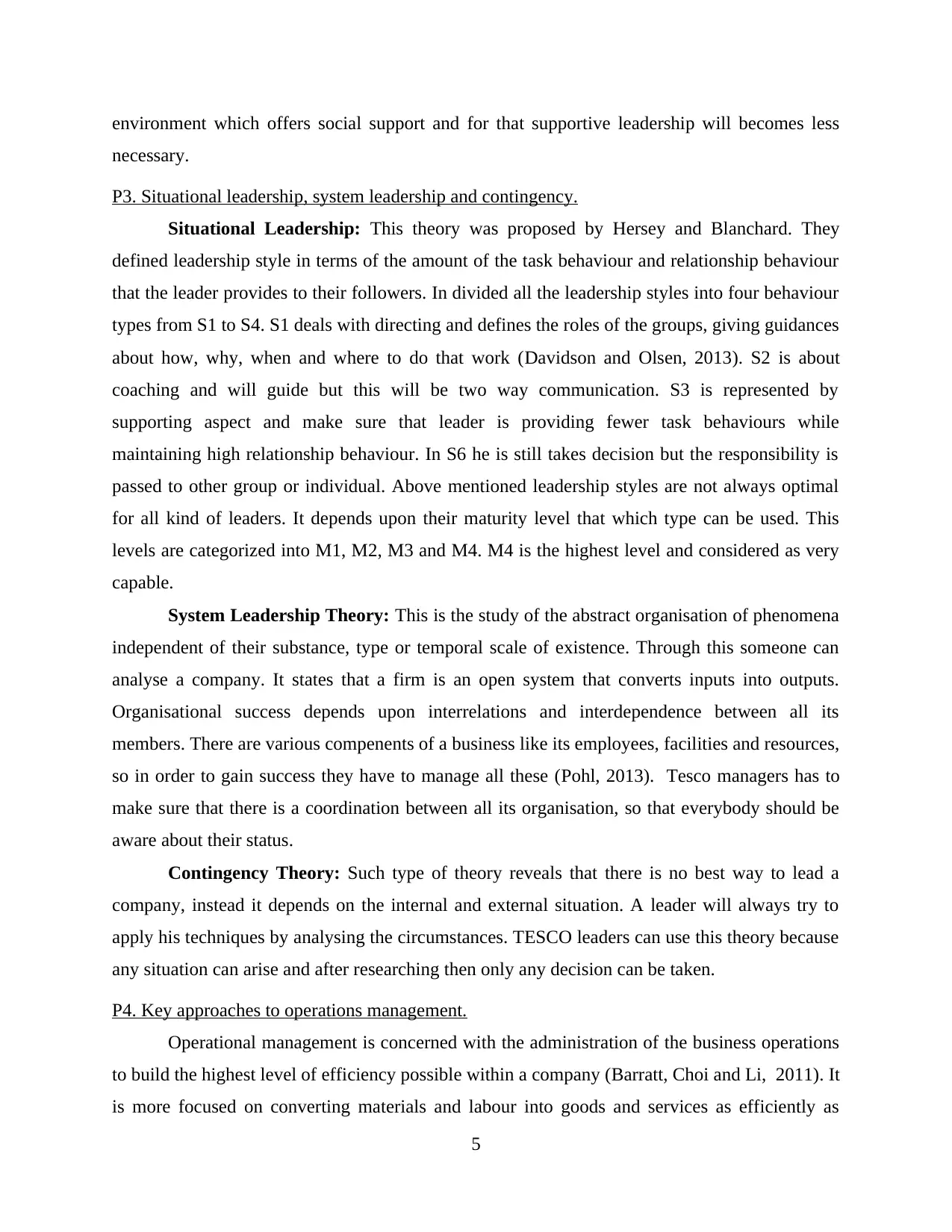
environment which offers social support and for that supportive leadership will becomes less
necessary.
P3. Situational leadership, system leadership and contingency.
Situational Leadership: This theory was proposed by Hersey and Blanchard. They
defined leadership style in terms of the amount of the task behaviour and relationship behaviour
that the leader provides to their followers. In divided all the leadership styles into four behaviour
types from S1 to S4. S1 deals with directing and defines the roles of the groups, giving guidances
about how, why, when and where to do that work (Davidson and Olsen, 2013). S2 is about
coaching and will guide but this will be two way communication. S3 is represented by
supporting aspect and make sure that leader is providing fewer task behaviours while
maintaining high relationship behaviour. In S6 he is still takes decision but the responsibility is
passed to other group or individual. Above mentioned leadership styles are not always optimal
for all kind of leaders. It depends upon their maturity level that which type can be used. This
levels are categorized into M1, M2, M3 and M4. M4 is the highest level and considered as very
capable.
System Leadership Theory: This is the study of the abstract organisation of phenomena
independent of their substance, type or temporal scale of existence. Through this someone can
analyse a company. It states that a firm is an open system that converts inputs into outputs.
Organisational success depends upon interrelations and interdependence between all its
members. There are various compenents of a business like its employees, facilities and resources,
so in order to gain success they have to manage all these (Pohl, 2013). Tesco managers has to
make sure that there is a coordination between all its organisation, so that everybody should be
aware about their status.
Contingency Theory: Such type of theory reveals that there is no best way to lead a
company, instead it depends on the internal and external situation. A leader will always try to
apply his techniques by analysing the circumstances. TESCO leaders can use this theory because
any situation can arise and after researching then only any decision can be taken.
P4. Key approaches to operations management.
Operational management is concerned with the administration of the business operations
to build the highest level of efficiency possible within a company (Barratt, Choi and Li, 2011). It
is more focused on converting materials and labour into goods and services as efficiently as
5
necessary.
P3. Situational leadership, system leadership and contingency.
Situational Leadership: This theory was proposed by Hersey and Blanchard. They
defined leadership style in terms of the amount of the task behaviour and relationship behaviour
that the leader provides to their followers. In divided all the leadership styles into four behaviour
types from S1 to S4. S1 deals with directing and defines the roles of the groups, giving guidances
about how, why, when and where to do that work (Davidson and Olsen, 2013). S2 is about
coaching and will guide but this will be two way communication. S3 is represented by
supporting aspect and make sure that leader is providing fewer task behaviours while
maintaining high relationship behaviour. In S6 he is still takes decision but the responsibility is
passed to other group or individual. Above mentioned leadership styles are not always optimal
for all kind of leaders. It depends upon their maturity level that which type can be used. This
levels are categorized into M1, M2, M3 and M4. M4 is the highest level and considered as very
capable.
System Leadership Theory: This is the study of the abstract organisation of phenomena
independent of their substance, type or temporal scale of existence. Through this someone can
analyse a company. It states that a firm is an open system that converts inputs into outputs.
Organisational success depends upon interrelations and interdependence between all its
members. There are various compenents of a business like its employees, facilities and resources,
so in order to gain success they have to manage all these (Pohl, 2013). Tesco managers has to
make sure that there is a coordination between all its organisation, so that everybody should be
aware about their status.
Contingency Theory: Such type of theory reveals that there is no best way to lead a
company, instead it depends on the internal and external situation. A leader will always try to
apply his techniques by analysing the circumstances. TESCO leaders can use this theory because
any situation can arise and after researching then only any decision can be taken.
P4. Key approaches to operations management.
Operational management is concerned with the administration of the business operations
to build the highest level of efficiency possible within a company (Barratt, Choi and Li, 2011). It
is more focused on converting materials and labour into goods and services as efficiently as
5
Paraphrase This Document
Need a fresh take? Get an instant paraphrase of this document with our AI Paraphraser
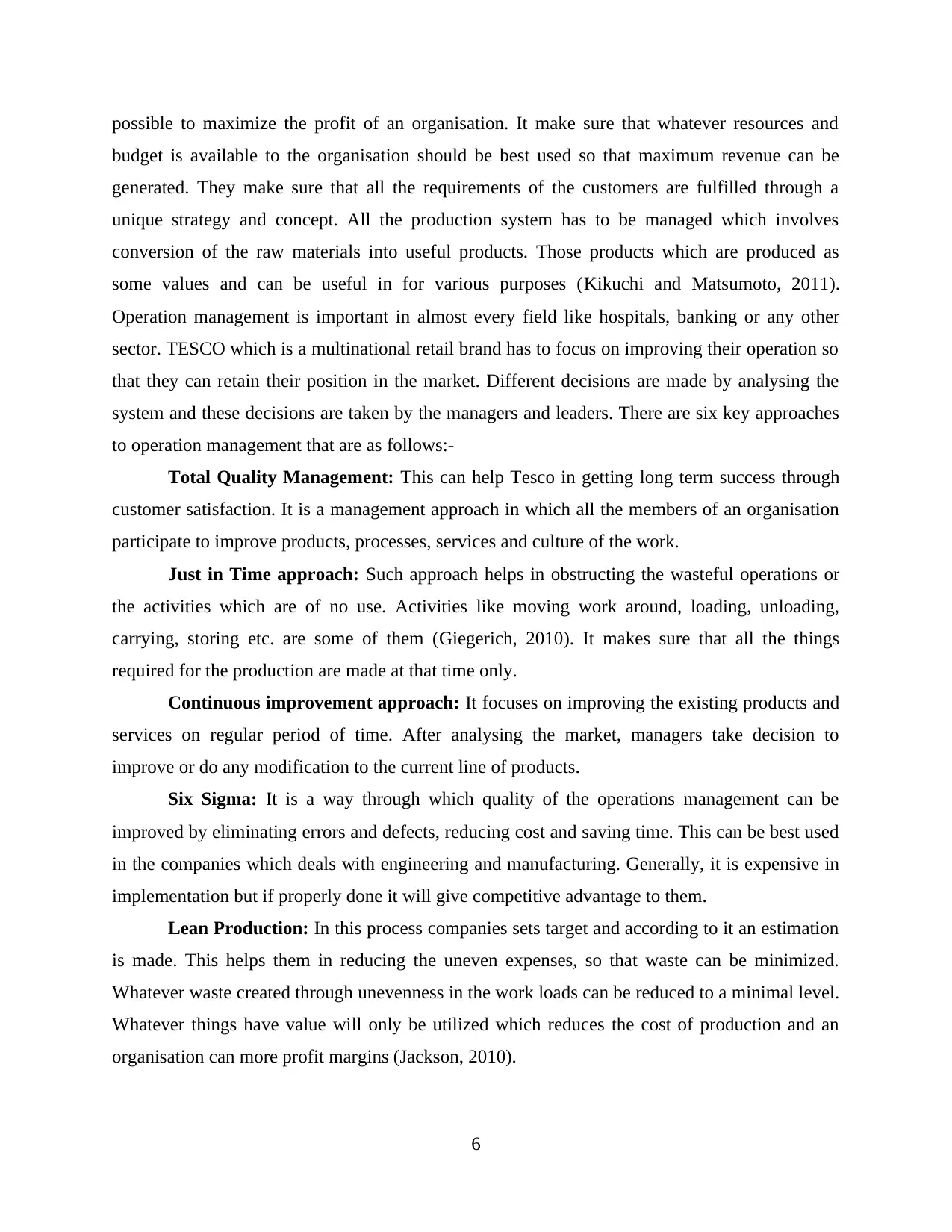
possible to maximize the profit of an organisation. It make sure that whatever resources and
budget is available to the organisation should be best used so that maximum revenue can be
generated. They make sure that all the requirements of the customers are fulfilled through a
unique strategy and concept. All the production system has to be managed which involves
conversion of the raw materials into useful products. Those products which are produced as
some values and can be useful in for various purposes (Kikuchi and Matsumoto, 2011).
Operation management is important in almost every field like hospitals, banking or any other
sector. TESCO which is a multinational retail brand has to focus on improving their operation so
that they can retain their position in the market. Different decisions are made by analysing the
system and these decisions are taken by the managers and leaders. There are six key approaches
to operation management that are as follows:-
Total Quality Management: This can help Tesco in getting long term success through
customer satisfaction. It is a management approach in which all the members of an organisation
participate to improve products, processes, services and culture of the work.
Just in Time approach: Such approach helps in obstructing the wasteful operations or
the activities which are of no use. Activities like moving work around, loading, unloading,
carrying, storing etc. are some of them (Giegerich, 2010). It makes sure that all the things
required for the production are made at that time only.
Continuous improvement approach: It focuses on improving the existing products and
services on regular period of time. After analysing the market, managers take decision to
improve or do any modification to the current line of products.
Six Sigma: It is a way through which quality of the operations management can be
improved by eliminating errors and defects, reducing cost and saving time. This can be best used
in the companies which deals with engineering and manufacturing. Generally, it is expensive in
implementation but if properly done it will give competitive advantage to them.
Lean Production: In this process companies sets target and according to it an estimation
is made. This helps them in reducing the uneven expenses, so that waste can be minimized.
Whatever waste created through unevenness in the work loads can be reduced to a minimal level.
Whatever things have value will only be utilized which reduces the cost of production and an
organisation can more profit margins (Jackson, 2010).
6
budget is available to the organisation should be best used so that maximum revenue can be
generated. They make sure that all the requirements of the customers are fulfilled through a
unique strategy and concept. All the production system has to be managed which involves
conversion of the raw materials into useful products. Those products which are produced as
some values and can be useful in for various purposes (Kikuchi and Matsumoto, 2011).
Operation management is important in almost every field like hospitals, banking or any other
sector. TESCO which is a multinational retail brand has to focus on improving their operation so
that they can retain their position in the market. Different decisions are made by analysing the
system and these decisions are taken by the managers and leaders. There are six key approaches
to operation management that are as follows:-
Total Quality Management: This can help Tesco in getting long term success through
customer satisfaction. It is a management approach in which all the members of an organisation
participate to improve products, processes, services and culture of the work.
Just in Time approach: Such approach helps in obstructing the wasteful operations or
the activities which are of no use. Activities like moving work around, loading, unloading,
carrying, storing etc. are some of them (Giegerich, 2010). It makes sure that all the things
required for the production are made at that time only.
Continuous improvement approach: It focuses on improving the existing products and
services on regular period of time. After analysing the market, managers take decision to
improve or do any modification to the current line of products.
Six Sigma: It is a way through which quality of the operations management can be
improved by eliminating errors and defects, reducing cost and saving time. This can be best used
in the companies which deals with engineering and manufacturing. Generally, it is expensive in
implementation but if properly done it will give competitive advantage to them.
Lean Production: In this process companies sets target and according to it an estimation
is made. This helps them in reducing the uneven expenses, so that waste can be minimized.
Whatever waste created through unevenness in the work loads can be reduced to a minimal level.
Whatever things have value will only be utilized which reduces the cost of production and an
organisation can more profit margins (Jackson, 2010).
6
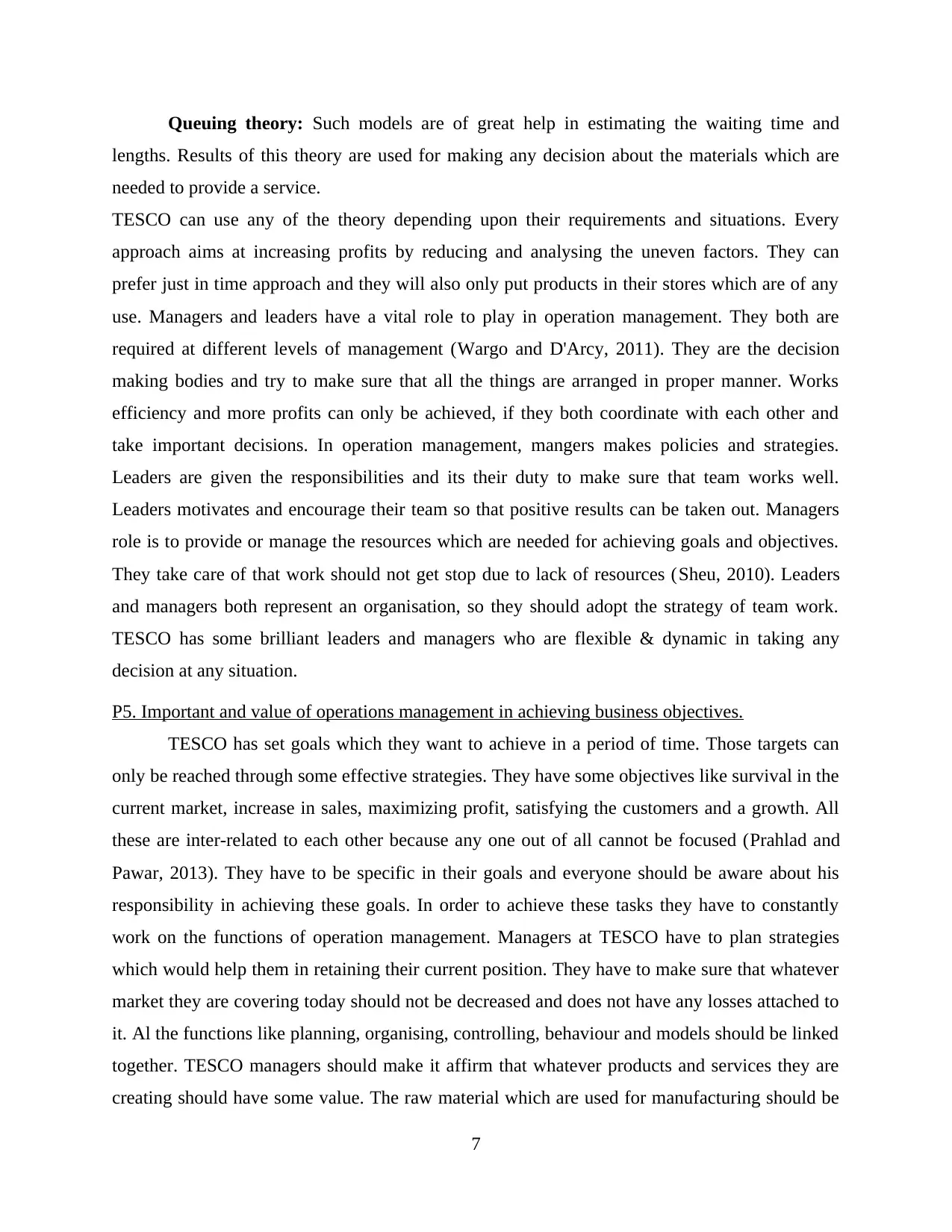
Queuing theory: Such models are of great help in estimating the waiting time and
lengths. Results of this theory are used for making any decision about the materials which are
needed to provide a service.
TESCO can use any of the theory depending upon their requirements and situations. Every
approach aims at increasing profits by reducing and analysing the uneven factors. They can
prefer just in time approach and they will also only put products in their stores which are of any
use. Managers and leaders have a vital role to play in operation management. They both are
required at different levels of management (Wargo and D'Arcy, 2011). They are the decision
making bodies and try to make sure that all the things are arranged in proper manner. Works
efficiency and more profits can only be achieved, if they both coordinate with each other and
take important decisions. In operation management, mangers makes policies and strategies.
Leaders are given the responsibilities and its their duty to make sure that team works well.
Leaders motivates and encourage their team so that positive results can be taken out. Managers
role is to provide or manage the resources which are needed for achieving goals and objectives.
They take care of that work should not get stop due to lack of resources (Sheu, 2010). Leaders
and managers both represent an organisation, so they should adopt the strategy of team work.
TESCO has some brilliant leaders and managers who are flexible & dynamic in taking any
decision at any situation.
P5. Important and value of operations management in achieving business objectives.
TESCO has set goals which they want to achieve in a period of time. Those targets can
only be reached through some effective strategies. They have some objectives like survival in the
current market, increase in sales, maximizing profit, satisfying the customers and a growth. All
these are inter-related to each other because any one out of all cannot be focused (Prahlad and
Pawar, 2013). They have to be specific in their goals and everyone should be aware about his
responsibility in achieving these goals. In order to achieve these tasks they have to constantly
work on the functions of operation management. Managers at TESCO have to plan strategies
which would help them in retaining their current position. They have to make sure that whatever
market they are covering today should not be decreased and does not have any losses attached to
it. Al the functions like planning, organising, controlling, behaviour and models should be linked
together. TESCO managers should make it affirm that whatever products and services they are
creating should have some value. The raw material which are used for manufacturing should be
7
lengths. Results of this theory are used for making any decision about the materials which are
needed to provide a service.
TESCO can use any of the theory depending upon their requirements and situations. Every
approach aims at increasing profits by reducing and analysing the uneven factors. They can
prefer just in time approach and they will also only put products in their stores which are of any
use. Managers and leaders have a vital role to play in operation management. They both are
required at different levels of management (Wargo and D'Arcy, 2011). They are the decision
making bodies and try to make sure that all the things are arranged in proper manner. Works
efficiency and more profits can only be achieved, if they both coordinate with each other and
take important decisions. In operation management, mangers makes policies and strategies.
Leaders are given the responsibilities and its their duty to make sure that team works well.
Leaders motivates and encourage their team so that positive results can be taken out. Managers
role is to provide or manage the resources which are needed for achieving goals and objectives.
They take care of that work should not get stop due to lack of resources (Sheu, 2010). Leaders
and managers both represent an organisation, so they should adopt the strategy of team work.
TESCO has some brilliant leaders and managers who are flexible & dynamic in taking any
decision at any situation.
P5. Important and value of operations management in achieving business objectives.
TESCO has set goals which they want to achieve in a period of time. Those targets can
only be reached through some effective strategies. They have some objectives like survival in the
current market, increase in sales, maximizing profit, satisfying the customers and a growth. All
these are inter-related to each other because any one out of all cannot be focused (Prahlad and
Pawar, 2013). They have to be specific in their goals and everyone should be aware about his
responsibility in achieving these goals. In order to achieve these tasks they have to constantly
work on the functions of operation management. Managers at TESCO have to plan strategies
which would help them in retaining their current position. They have to make sure that whatever
market they are covering today should not be decreased and does not have any losses attached to
it. Al the functions like planning, organising, controlling, behaviour and models should be linked
together. TESCO managers should make it affirm that whatever products and services they are
creating should have some value. The raw material which are used for manufacturing should be
7
⊘ This is a preview!⊘
Do you want full access?
Subscribe today to unlock all pages.

Trusted by 1+ million students worldwide
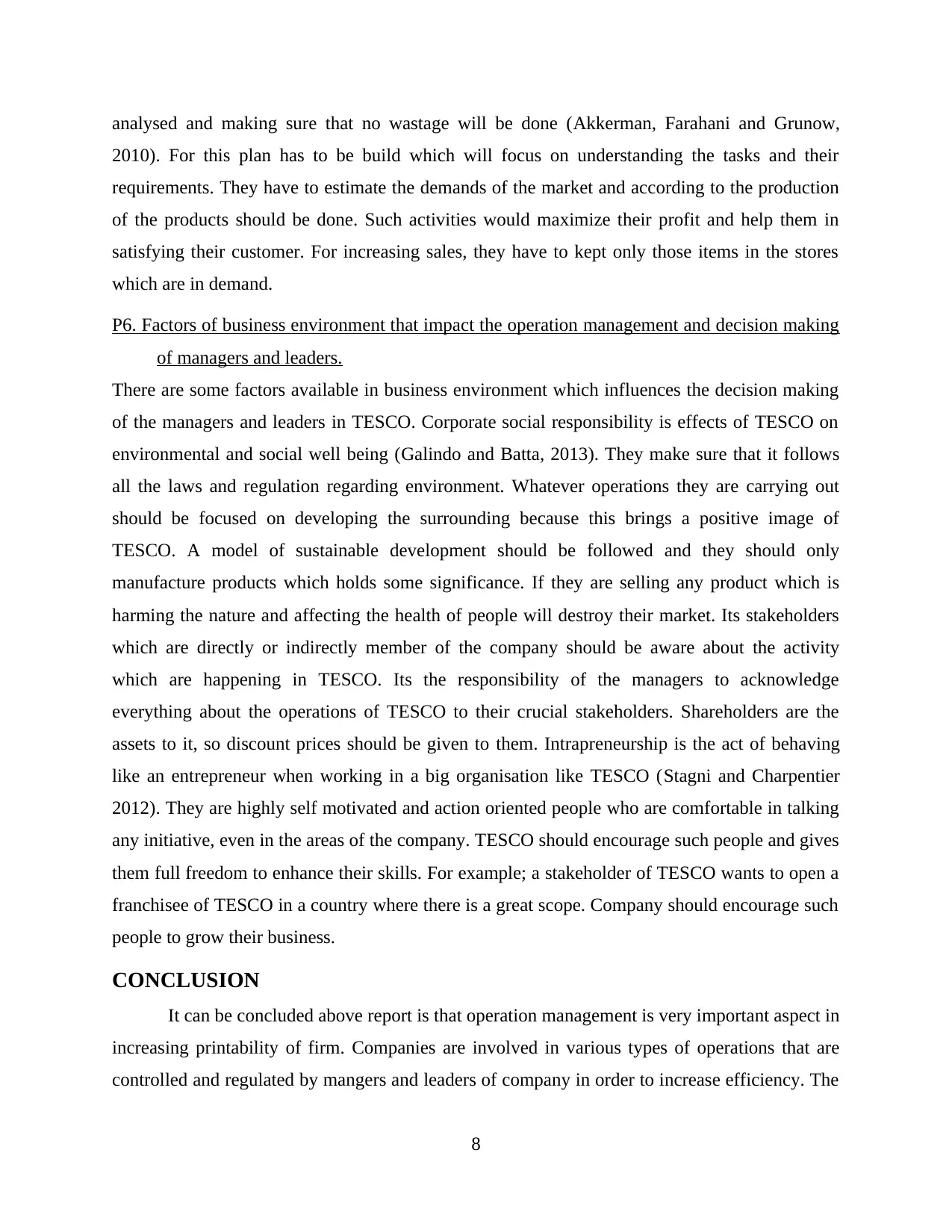
analysed and making sure that no wastage will be done (Akkerman, Farahani and Grunow,
2010). For this plan has to be build which will focus on understanding the tasks and their
requirements. They have to estimate the demands of the market and according to the production
of the products should be done. Such activities would maximize their profit and help them in
satisfying their customer. For increasing sales, they have to kept only those items in the stores
which are in demand.
P6. Factors of business environment that impact the operation management and decision making
of managers and leaders.
There are some factors available in business environment which influences the decision making
of the managers and leaders in TESCO. Corporate social responsibility is effects of TESCO on
environmental and social well being (Galindo and Batta, 2013). They make sure that it follows
all the laws and regulation regarding environment. Whatever operations they are carrying out
should be focused on developing the surrounding because this brings a positive image of
TESCO. A model of sustainable development should be followed and they should only
manufacture products which holds some significance. If they are selling any product which is
harming the nature and affecting the health of people will destroy their market. Its stakeholders
which are directly or indirectly member of the company should be aware about the activity
which are happening in TESCO. Its the responsibility of the managers to acknowledge
everything about the operations of TESCO to their crucial stakeholders. Shareholders are the
assets to it, so discount prices should be given to them. Intrapreneurship is the act of behaving
like an entrepreneur when working in a big organisation like TESCO (Stagni and Charpentier
2012). They are highly self motivated and action oriented people who are comfortable in talking
any initiative, even in the areas of the company. TESCO should encourage such people and gives
them full freedom to enhance their skills. For example; a stakeholder of TESCO wants to open a
franchisee of TESCO in a country where there is a great scope. Company should encourage such
people to grow their business.
CONCLUSION
It can be concluded above report is that operation management is very important aspect in
increasing printability of firm. Companies are involved in various types of operations that are
controlled and regulated by mangers and leaders of company in order to increase efficiency. The
8
2010). For this plan has to be build which will focus on understanding the tasks and their
requirements. They have to estimate the demands of the market and according to the production
of the products should be done. Such activities would maximize their profit and help them in
satisfying their customer. For increasing sales, they have to kept only those items in the stores
which are in demand.
P6. Factors of business environment that impact the operation management and decision making
of managers and leaders.
There are some factors available in business environment which influences the decision making
of the managers and leaders in TESCO. Corporate social responsibility is effects of TESCO on
environmental and social well being (Galindo and Batta, 2013). They make sure that it follows
all the laws and regulation regarding environment. Whatever operations they are carrying out
should be focused on developing the surrounding because this brings a positive image of
TESCO. A model of sustainable development should be followed and they should only
manufacture products which holds some significance. If they are selling any product which is
harming the nature and affecting the health of people will destroy their market. Its stakeholders
which are directly or indirectly member of the company should be aware about the activity
which are happening in TESCO. Its the responsibility of the managers to acknowledge
everything about the operations of TESCO to their crucial stakeholders. Shareholders are the
assets to it, so discount prices should be given to them. Intrapreneurship is the act of behaving
like an entrepreneur when working in a big organisation like TESCO (Stagni and Charpentier
2012). They are highly self motivated and action oriented people who are comfortable in talking
any initiative, even in the areas of the company. TESCO should encourage such people and gives
them full freedom to enhance their skills. For example; a stakeholder of TESCO wants to open a
franchisee of TESCO in a country where there is a great scope. Company should encourage such
people to grow their business.
CONCLUSION
It can be concluded above report is that operation management is very important aspect in
increasing printability of firm. Companies are involved in various types of operations that are
controlled and regulated by mangers and leaders of company in order to increase efficiency. The
8
Paraphrase This Document
Need a fresh take? Get an instant paraphrase of this document with our AI Paraphraser
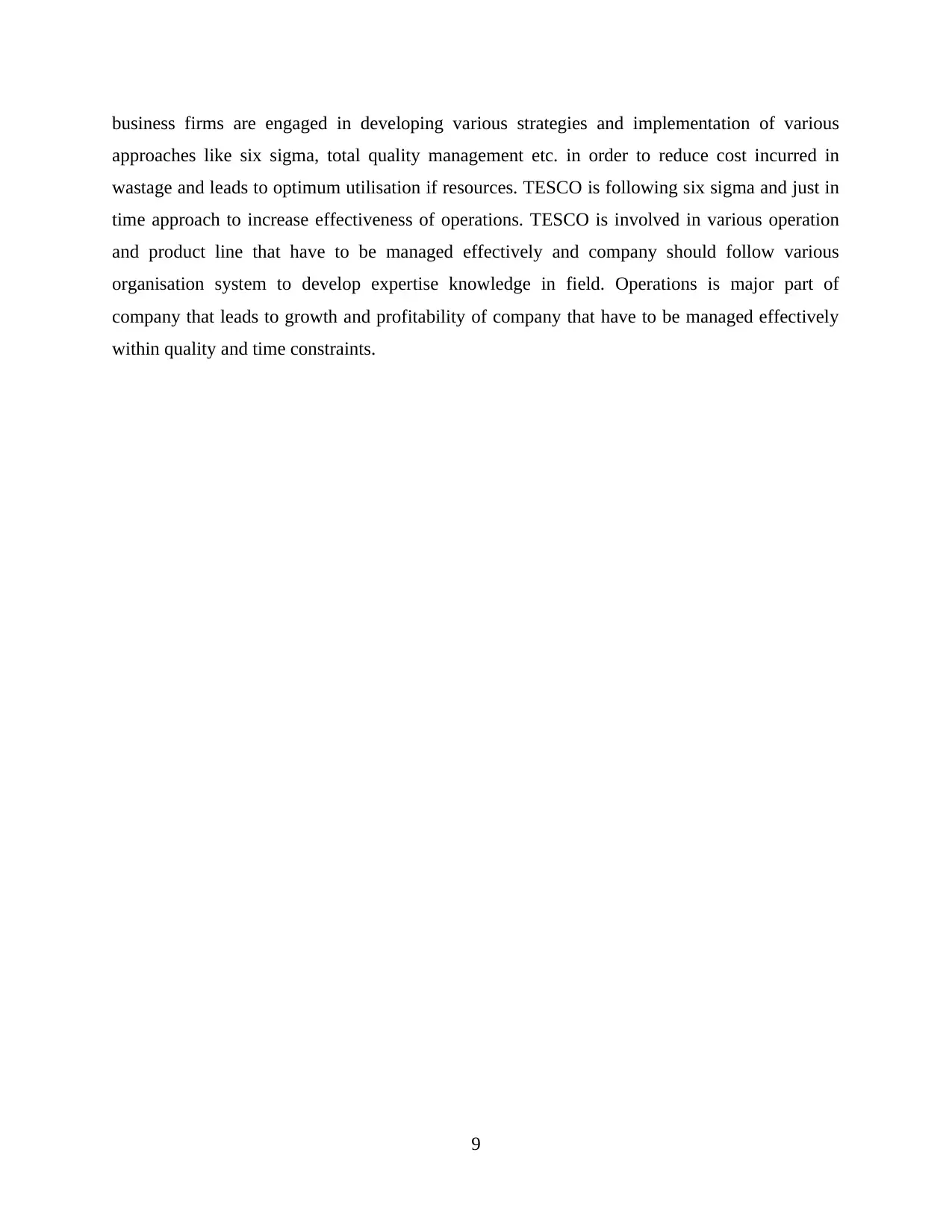
business firms are engaged in developing various strategies and implementation of various
approaches like six sigma, total quality management etc. in order to reduce cost incurred in
wastage and leads to optimum utilisation if resources. TESCO is following six sigma and just in
time approach to increase effectiveness of operations. TESCO is involved in various operation
and product line that have to be managed effectively and company should follow various
organisation system to develop expertise knowledge in field. Operations is major part of
company that leads to growth and profitability of company that have to be managed effectively
within quality and time constraints.
9
approaches like six sigma, total quality management etc. in order to reduce cost incurred in
wastage and leads to optimum utilisation if resources. TESCO is following six sigma and just in
time approach to increase effectiveness of operations. TESCO is involved in various operation
and product line that have to be managed effectively and company should follow various
organisation system to develop expertise knowledge in field. Operations is major part of
company that leads to growth and profitability of company that have to be managed effectively
within quality and time constraints.
9
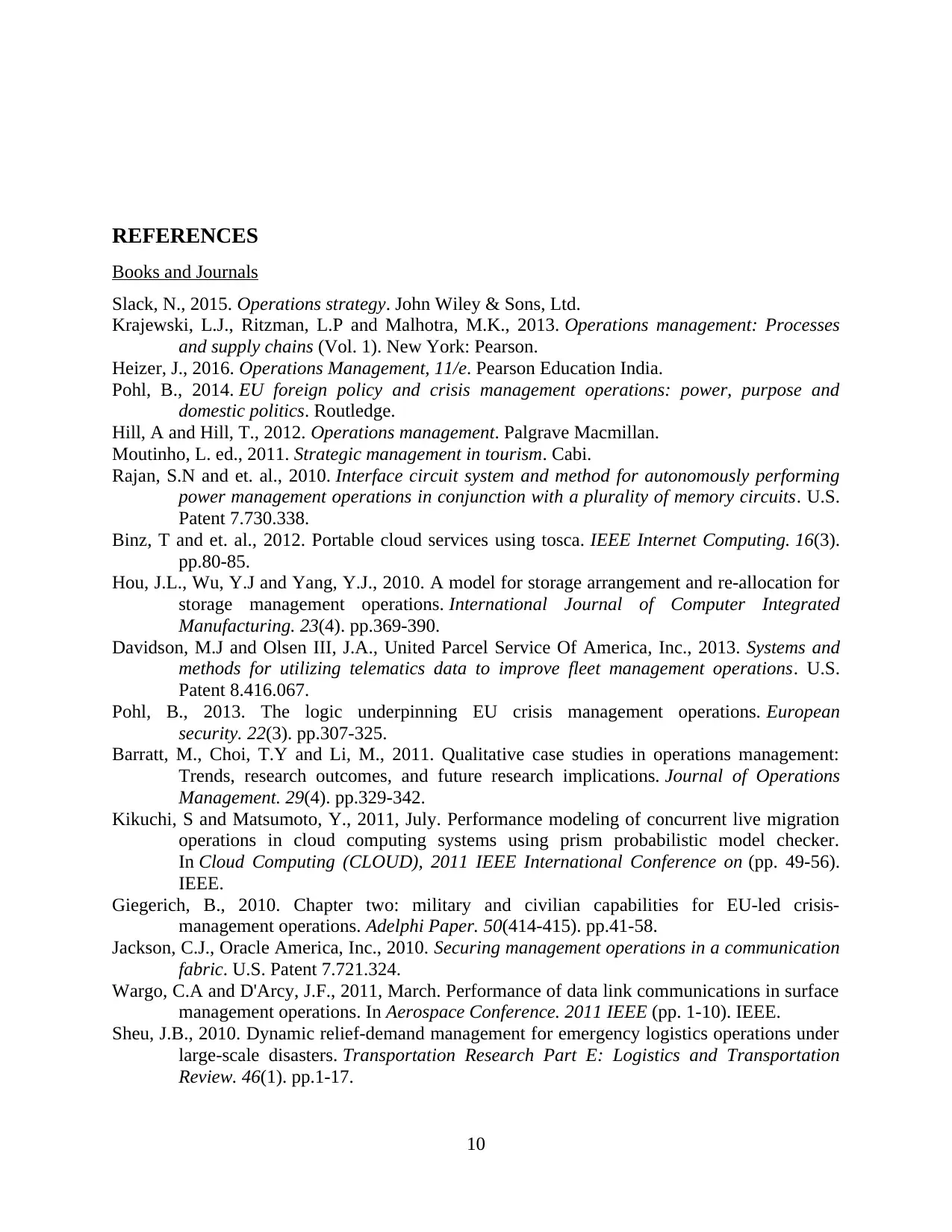
REFERENCES
Books and Journals
Slack, N., 2015. Operations strategy. John Wiley & Sons, Ltd.
Krajewski, L.J., Ritzman, L.P and Malhotra, M.K., 2013. Operations management: Processes
and supply chains (Vol. 1). New York: Pearson.
Heizer, J., 2016. Operations Management, 11/e. Pearson Education India.
Pohl, B., 2014. EU foreign policy and crisis management operations: power, purpose and
domestic politics. Routledge.
Hill, A and Hill, T., 2012. Operations management. Palgrave Macmillan.
Moutinho, L. ed., 2011. Strategic management in tourism. Cabi.
Rajan, S.N and et. al., 2010. Interface circuit system and method for autonomously performing
power management operations in conjunction with a plurality of memory circuits. U.S.
Patent 7.730.338.
Binz, T and et. al., 2012. Portable cloud services using tosca. IEEE Internet Computing. 16(3).
pp.80-85.
Hou, J.L., Wu, Y.J and Yang, Y.J., 2010. A model for storage arrangement and re-allocation for
storage management operations. International Journal of Computer Integrated
Manufacturing. 23(4). pp.369-390.
Davidson, M.J and Olsen III, J.A., United Parcel Service Of America, Inc., 2013. Systems and
methods for utilizing telematics data to improve fleet management operations. U.S.
Patent 8.416.067.
Pohl, B., 2013. The logic underpinning EU crisis management operations. European
security. 22(3). pp.307-325.
Barratt, M., Choi, T.Y and Li, M., 2011. Qualitative case studies in operations management:
Trends, research outcomes, and future research implications. Journal of Operations
Management. 29(4). pp.329-342.
Kikuchi, S and Matsumoto, Y., 2011, July. Performance modeling of concurrent live migration
operations in cloud computing systems using prism probabilistic model checker.
In Cloud Computing (CLOUD), 2011 IEEE International Conference on (pp. 49-56).
IEEE.
Giegerich, B., 2010. Chapter two: military and civilian capabilities for EU-led crisis-
management operations. Adelphi Paper. 50(414-415). pp.41-58.
Jackson, C.J., Oracle America, Inc., 2010. Securing management operations in a communication
fabric. U.S. Patent 7.721.324.
Wargo, C.A and D'Arcy, J.F., 2011, March. Performance of data link communications in surface
management operations. In Aerospace Conference. 2011 IEEE (pp. 1-10). IEEE.
Sheu, J.B., 2010. Dynamic relief-demand management for emergency logistics operations under
large-scale disasters. Transportation Research Part E: Logistics and Transportation
Review. 46(1). pp.1-17.
10
Books and Journals
Slack, N., 2015. Operations strategy. John Wiley & Sons, Ltd.
Krajewski, L.J., Ritzman, L.P and Malhotra, M.K., 2013. Operations management: Processes
and supply chains (Vol. 1). New York: Pearson.
Heizer, J., 2016. Operations Management, 11/e. Pearson Education India.
Pohl, B., 2014. EU foreign policy and crisis management operations: power, purpose and
domestic politics. Routledge.
Hill, A and Hill, T., 2012. Operations management. Palgrave Macmillan.
Moutinho, L. ed., 2011. Strategic management in tourism. Cabi.
Rajan, S.N and et. al., 2010. Interface circuit system and method for autonomously performing
power management operations in conjunction with a plurality of memory circuits. U.S.
Patent 7.730.338.
Binz, T and et. al., 2012. Portable cloud services using tosca. IEEE Internet Computing. 16(3).
pp.80-85.
Hou, J.L., Wu, Y.J and Yang, Y.J., 2010. A model for storage arrangement and re-allocation for
storage management operations. International Journal of Computer Integrated
Manufacturing. 23(4). pp.369-390.
Davidson, M.J and Olsen III, J.A., United Parcel Service Of America, Inc., 2013. Systems and
methods for utilizing telematics data to improve fleet management operations. U.S.
Patent 8.416.067.
Pohl, B., 2013. The logic underpinning EU crisis management operations. European
security. 22(3). pp.307-325.
Barratt, M., Choi, T.Y and Li, M., 2011. Qualitative case studies in operations management:
Trends, research outcomes, and future research implications. Journal of Operations
Management. 29(4). pp.329-342.
Kikuchi, S and Matsumoto, Y., 2011, July. Performance modeling of concurrent live migration
operations in cloud computing systems using prism probabilistic model checker.
In Cloud Computing (CLOUD), 2011 IEEE International Conference on (pp. 49-56).
IEEE.
Giegerich, B., 2010. Chapter two: military and civilian capabilities for EU-led crisis-
management operations. Adelphi Paper. 50(414-415). pp.41-58.
Jackson, C.J., Oracle America, Inc., 2010. Securing management operations in a communication
fabric. U.S. Patent 7.721.324.
Wargo, C.A and D'Arcy, J.F., 2011, March. Performance of data link communications in surface
management operations. In Aerospace Conference. 2011 IEEE (pp. 1-10). IEEE.
Sheu, J.B., 2010. Dynamic relief-demand management for emergency logistics operations under
large-scale disasters. Transportation Research Part E: Logistics and Transportation
Review. 46(1). pp.1-17.
10
⊘ This is a preview!⊘
Do you want full access?
Subscribe today to unlock all pages.

Trusted by 1+ million students worldwide
1 out of 13
Related Documents
Your All-in-One AI-Powered Toolkit for Academic Success.
+13062052269
info@desklib.com
Available 24*7 on WhatsApp / Email
![[object Object]](/_next/static/media/star-bottom.7253800d.svg)
Unlock your academic potential
Copyright © 2020–2025 A2Z Services. All Rights Reserved. Developed and managed by ZUCOL.





